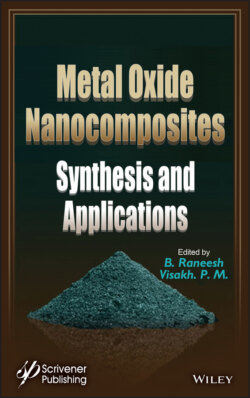Читать книгу Metal Oxide Nanocomposites - Группа авторов - Страница 16
1.4 Metal Oxide-Based Nanocomposites Application Towards Photocatalysis
ОглавлениеPhotocatalysis has long been studied and is expected to make a great contribution to both environmental treatment (emission cleaning and water purification) and renewable energy. Over the past few decades, the number of applications based on photocatalysis increased sharply; while a wide range of materials systems have been developed [73]. Photocatalytic H2 production from water is one of the most promising ways to realize a hydrogen economy for three reasons. (1) This technology is based on photon (or solar) energy, which is a clean, permanent source of energy, and mainly water, which is a renewable resource; (2) it is an environmental safe technology without undesirable by-products and pollutants; and (3) the photochemical conversion of solar energy into a storable form of energy, i.e. hydrogen allows to deal with the intermittent character and seasonal variation of the solar influx. Nano science and nanotechnology have boosted the modification of existing photocatalysts and the discovery and development of new candidate materials [74]. The rapidly increasing number of scientific publications constitutes clear bibliographical evidence for the significance of this hot topic. The valence holes are good oxidants and the conduction electrons are reductants. In most cases, the organic compounds are degraded by oxidation reaction involving photogenerated holes. Since 1972, scientists discovered the photocatalytic splitting of water on the illuminated single crystal TiO2 electrodes [75], the photocatalysis as a research area is of significant interest and photocatalytic processes have been extensively studied.
The adoption of TiO2 photoanode as well as a Pt counter electrode soaked in an aqueous electrolytic solution made it possible for the water to be incised, which was caused by UV light. This was conducted by Honda and Fujishima in 1972. It has been issued that the charge clipping and photocatalytic performance can be improved by combination of semiconductor with a wide band gap like SnO2 with TiO2 [76, 77]. There is an effective of promoting the photocatalytic performance of visible light, namely TiO2 matrix is inserted with the combination of metal ions. The principle of this approach is through blocked charge carrier recombination [78]. The insertion of the metal ion promotes the shape of Ti3+ ions, thus improving the photocatalytic performance. Transforming the TiO2 through incorporation of two or more than two dopants is issued, which makes great combination influence. On the contrary, the undoped TiO2 or the TiO2 with one ion incorporated is less effective [79, 80]. Surface spots, oxygen vacancies and polar planes contribute the difference in photocatalytic performance of ZnO. With solvothermal technique, Xu et al. synthesized carious forms of ZnO and adopted them as photocatalyst to degrade the phenol [81].
These researchers proposed that nanoflowers and NPs indicated boosted photodegradation outcomes in comparison to nanoflowers, nanorods, nanotubes, as well as hour-glass-like ZnO spheres. To photodegrade phenol, Liu et al. used TiO2 nanostructures with various forms such as microspheres, NPs and nanorods though hydrothermal approach [82]. With nanorods to be photocatalyst, this group of researchers gained marvelous photodegradation outcomes. ZnO has come into the researchers’ focus since 1935, but its excellent features are discovered through modern methods and improved equipment [83]. Liang et al. [84] found that the generated graphene–TiO2 nanocrystal combination featured advanced photocatalytic performance in contrast to other TiO2 materials like P25, bare TiO2 and mixture of P25 and GO handled by hydrothermal procedure, in the splitting process of rhodamine B with UV irradiation, boosting a three-fold photocatalytic influence on P25. Metal oxide appearances indicate that it is good at decomposing organic molecules with great oxidizing ability for and superhydrophilicity [85, 86] and such traits could be adopted to generate wettability patterns, which have been adopted in many areas like in printed-circuit boards and offset printing, and can be used for fluid microchips in the future [87, 88].
